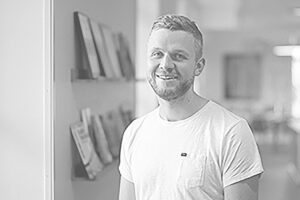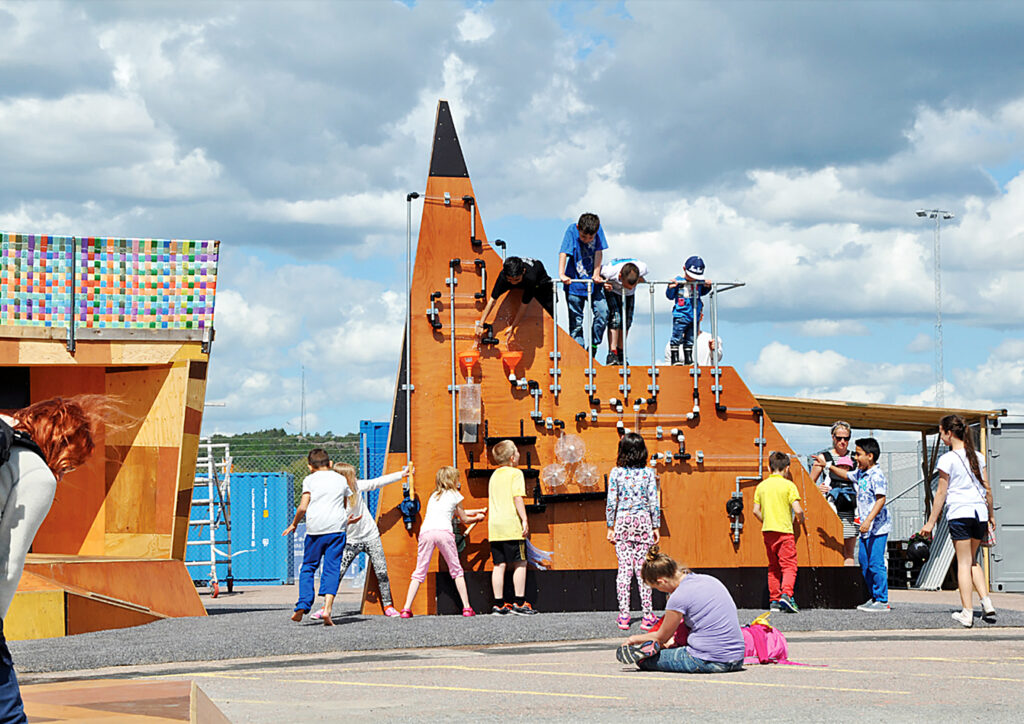Gothenburg’s Jubileumsparken is being designed with an open mind and all changes are welcomed with open arms: it is still unclear what kind of spatial disruptions will be implemented and where these manipulations will come into play. This depends on the parties involved and their reactions to the process.
In 2021 the city of Gothenburg in Western Sweden will celebrate its 400th anniversary. The approaching festivities have kick-started a number of large-scale urban construction projects that all share a common denominator – physically and conceptually connecting the two river banks and eradicating this aquatic barrier at the heart of the city. By the time 2021 rolls around, both a new bridge and a futuristic cable car system should have been constructed. However, the most hotly debated topic concerns the old harbour area Frihamnen where a new district connecting the two banks is being developed. A public park (Jubileumsparken) will become the centre of this area.
Area & background
Frihamnen (meaning “free harbour”) was built in the centre of Gothenburg in 1920. It is an industrial space where there used to be a harbour, but it has ceased operations. Today it is an open space with concrete and a few warehouses still left standing. There are residential areas right by Frihamnen, but in general the space gets its character from large infrastructure systems: bridges, railways, tramways and motorways. Despite this, or rather because of it, the area is not easily accessible.

Jubileumsparken 0.5
In parallel with the detailed plan, a place-making project named Jubileumsparken 0.5 has also been given the green light. The name hints at the fact that we are dealing with a process-in-progress, rather than a complete solution. The city has defined the project’s objective as follows: it aims to research, develop and implement new and alternative methods that focus on planning the community and creating dialogue. In practice this means that the area will be used in an intermediate way – an area that has been closed off for decades will be brought back to people’s minds; it will be used before a new district becomes established. One goal in this process is to figure out what the location-specific values and landscapes worth retaining and creating during the development of the park and the district are.
Many curious prototype constructions have been built in the Jubileumsparken with temporary building permits: a sauna, a pool, a sandy beach, a playground, a rollerblading track, a community garden, a sailing school and more. These popular facilities will likely be incorporated into the final park in the future, though perhaps in slightly different ways. One ideal to aim for when making these ideas come to life is incorporating people – a large portion of the buildings in Jubileumsparken have been developed in workshops. Citizens got to take out their shovels and hammers and contribute to the completion of the park themselves.
Over the years, different internationally renowned architecture bureaus have been incorporated through contests into mapping existing values, strategic development and the implementation of place-making activities. These companies include MUF, White, Raumlabor Berlin, SelgasCano and Topotek1.

Working with two dimensions: the temporary and the permanent
The architects are going down two parallel paths: that of the temporary park and that of the permanent park. There are several reasons for this. Firstly, the location of the future park has yet to be confirmed. This means that the structure of the buildings in the area is not fixed in place and debate between the city, specialists and the developers remains fierce. Secondly, the soil in the area of the old harbour and industries is highly polluted, so this pollution has to be cleared before permanent buildings and parks can be constructed.
In addition, these temporary buildings and the park’s functions are constantly being assessed to figure out what works and what doesn’t, what could be done better and which solutions are not favoured by the on-site conditions.
A park as an exhibition
Creating the Jubileumsparken is comparable to curating an exhibition. There are project managers who have been collaborating with dozens of different artists, architects and landscape architects since 2012, all of whom have contributed to creating different layers of innovation. Since its opening, at least one new function per year has been added to the park and the number of visitors has constantly increased. Due to this, the public have developed certain expectations concerning exciting additions and the people behind the project sense a growing pressure to grant those wishes. In and of itself there’s nothing wrong with that. However, you could see in the early years that the framework, requirements and duties were far more relaxed than they are now. The closer the big anniversary celebrations are, the bigger the public attention and the stricter (i.e. more guided by legislation) the rules become. This intrinsically entails a clash: we want to keep our creative freedom and opportunity to experiment while accepting that we will be held accountable by politicians and the public. At the same time, the project has received attention and support from professional circles precisely because of its experimental nature and its boldness in trying different things and rethinking old solutions.
Exploring incorporation – how spaces are created
Sweden is characterised by a very strong culture of dialogue, so there is nothing exceptional about the idea of incorporating citizens into the process of building Jubileumsparken. However, wishing to take a step beyond theoretical place-making to build the park together with citizens is something innovative and ambitious.
There seems to be a deeply rooted belief in Sweden that it is citizens’ duty to go to work and contribute to the state’s development by paying taxes and voting. (High voter turnout confirms this: in 2018, 87% voted in elections.) The task of the state and local municipalities is to use their budgets sensibly, manage local life and offer their citizens high-quality public services. This doesn’t mean the Swedes aren’t active in non-profit organisations in their free time; quite the contrary, clubs and associations are popular. But there is no practice of diving into municipal issues and taking a hands-on approach.
As such, when Raumlabor Berlin organised workshops in summer 2015 and invited citizens to participate, the organisers only recruited a few helping hands. After all, it was summer, Midsummer’s eve, school was out for students…
We could draw parallels with the World Clean-up Day (Teeme Ära) initiative: friends and workmates gathered in groups of their own accord; you only had to send out an invitation. It wouldn’t work this way in Sweden. The tasks of local municipalities are clearly defined and funded by citizens via their high taxes. For citizens to come and also voluntarily contribute their time to a cause, there would have to be a true crisis.

The city has now developed a large network of schools and organisations that wish to participate in creating the park. Contributors register prior to workshops and organisers make sure every place-maker gets soup and bread. The entire process has been thought through to the last detail: there are no surprises. Everything works the way it is expected to and there’s a very Swedish sense of order.
It’s crucial to note that the idea of communal place-making derives from a wish to promote integration. Gothenburg is segregated, and many locals don’t even know anyone from the other side of the river. On paper and in theory the Jubileumsparken concept also strives, in a noble-minded sort of way, to bring citizens from different parts of the city together. In practice it is not that simple, but Jubileumsparken has proved its value as a new meeting place. Bit by bit, the activities initiated in the park are definitely contributing to the goal of integration.

KADRI KOPPEL is an urban sociologist and a sustainable development consultant who has been living and working in Gothenburg since 2015.

MARTIN ALLIK is a landscape architect who has been living and working in Gothenburg since 2012. He has been part of the Jubileumsparken (Jubilee Park) project for the past three years.
HEADER: in 2015 a playground/attraction called The Mountain (Berget) was opened. It could officially be considered a piece of art, yet it’s hugely popular with children because of its unusual and diverse opportunities for playing. Kids’ fantasies are larger than life and they imagine things adults don’t think of. Thus they’ve started using The Mountain in ways that surprise even the designer of the construction. Photo by Movium Fakta
PUBLISHED: Maja 95 (winter 2019), with main topic Drift





